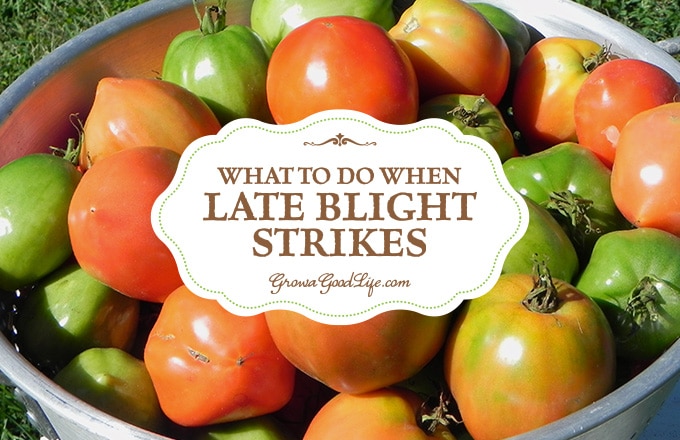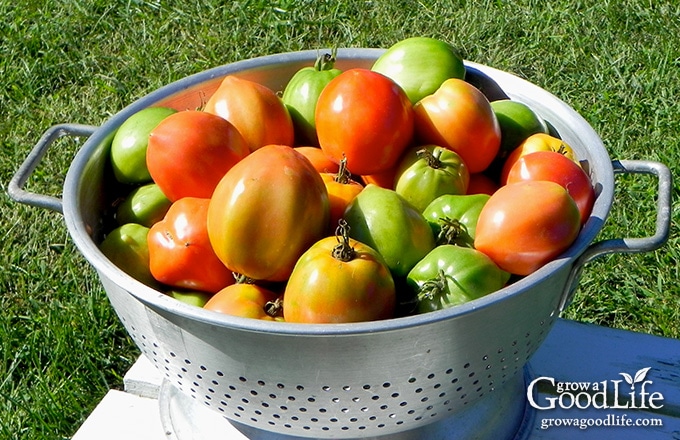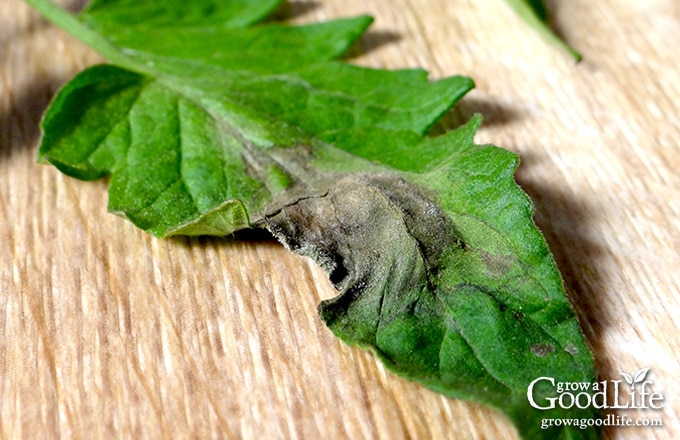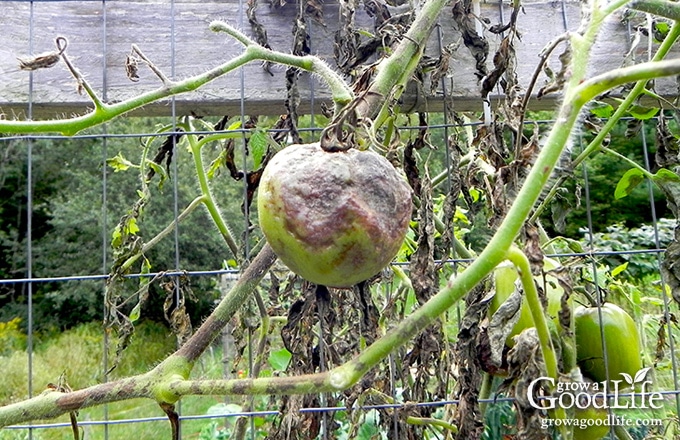What to Do When Late Blight Strikes Your Tomatoes
This post may contain affiliate links, which means that I may receive a commission if you make a purchase using these links. As an Amazon Associate I earn from qualifying purchases.
Late blight is not a treatable disease and it will kill your plants. In addition, late blight is highly communicable disease that is carried on wind and will infect other gardens and farms within a 50-mile radius. So it is important to destroy infected plants once you confirm you have late blight.

Even with my crazy, busy schedule lately, I take the time to walk through the garden at least once a day. It calms me to be among the plants that I tend to that provides us with nourishing, healthy, organic food.
I carry a basket with me during this walk in order to harvest what is ready. I often munch on pole beans as I frown at the weeds that are taking over, check to see if there are any problems with pests or diseases, and plan what garden tasks to accomplish over the weekend.
Spotting Late Blight
Several weeks ago, I spotted what looked like Late Blight on the foliage of my Amish Paste tomatoes. A quick check online at MOFGA’s Pest Reports and USAblight confirmed that Late Blight had been recently reported in my area.
As a precaution, I harvested all the partially ripe tomatoes, quarantined them to the shed, trimmed off the diseased foliage, bagged and disposed it with the household trash, and watched it to see if it spread.

Unfortunately, it did. Not as quickly as in 2009 because of the dry weather, but rapidly enough for me to realize I had to take action.
2009 was a Crash Course in Late Blight:
I’ve been rather paranoid about Late Blight ever since the 2009 pandemic that that took down much of the tomato plants in the Northeast. Like many backyard gardeners, I knew nothing about the disease at the time and had never experienced it before.
The 2009 late blight pandemic was an unusual situation. First, a large plant supplier provided late blight infected plants to big box stores along the East Coast. Then the cool and damp weather allowed the spores to multiply and spread quickly. Eventually, most of us on the East Coast lost our tomatoes that year.
Late blight caused by the fungus, Phytophthora infestans, which primarily attacks plants in the Solanaceae family such as potato and tomato crops. This is the same disease that caused the Great Potato Famines in Europe and Ireland the 1840-50.
The fungus makes its first appearance as water soaked lesions on the younger leaves at the top of the plant. Then continues to spread by spores eventually infecting the entire plant including fruit and stems. The result is the tomatoes rot.

Gardening blogs and forums began reporting late blight in June of 2009. I studied the photos online and scouted my plants daily. The weather in July 2009 was cold and rainy and the perfect situation for a fungus to spread. Eventually my tomato plants began showing symptoms of the Late Blight disease and were pulled before even a single tomato ripened.
Visit the Cornell University website for more information on Late Blight.
So what do you do when you discover late blight in your garden??
Unfortunately, Late blight is not a treatable disease and it will kill your plants. In addition, late blight is highly communicable disease that is carried on wind and will infect other gardens and farms within a 50-mile radius. So it is important to destroy infected plants once you confirm you have late blight.
If you are unsure that your plants are infected with late blight, contact your local Extension Office. Often times they will be able to identify the disease by looking a good quality photo. Once confirmed, you need to destroy all infected plants.

1. Pull the Late Blight Infected Plants: Pull and remove infected plants, bag up the foliage and unripe tomatoes into black trash bags, and disposed it along with the household trash. Do not compost diseased plants or fruit. Most compost piles are not hot enough to kill the spores and you are risking re-infecting your garden next season.
2. Prevent Overwintering Late Blight: Late blight can only survive on living tissue. Winters in the North will kill any spores that may linger above ground on trellises and tomato cages. However, late blight CAN over winter in plant debris, seeds, and potato tubers underground beneath the frost line. To be safe, make sure all plant debris is cleaned up at the end of the season, purchase fresh seeds for next year, and pull any volunteer potatoes and tomato plants that sprout up.
3. Start Again Fresh Next Year: At this point all we can do is cut our losses and hope for a better growing season next year. In all, I probably lost about a month of potential tomatoes. Even though my tomato season was cut short this year, I feel lucky because I was able to harvest a lot of tomatoes before the disease struck. I have already filled my pantry with plenty of canned tomato sauce and salsa from healthy tomatoes.
Luckily, the potatoes had already died back when the Late Blight disease showed itself on the tomato plants. Since there was no live foliage, I don’t expect the potatoes to be infected. To be on the safe side, I bagged up the dead potato foliage. The potato tubers will not be dug up until later in the fall once all danger of the disease is gone.
“A garden is never so good as it will be next year.” ~ Thomas Cooper
Further Reading:
- The American Phytopathological Society. “The 2009 Late Blight Pandemic in Eastern USA“
- “Late blight ‘imitators’.” Department of Horticulture Website at Cornell University
- Preventing Late Blight in Tomatoes – Learning and Yearning
You May Also Like:
- How to Root Tomato Suckers and Grow New Plants
- 13 Quick Growing Vegetables for Fall
- 5 Steps to Storing Potatoes for Winter
Good planning is key to a successful vegetable garden
Whether you are new to growing your own food or have been growing a vegetable garden for years, you will benefit from some planning each year. You will find everything you need to organize and plan your vegetable garden in my PDF eBook, Grow a Good Life Guide to Planning Your Vegetable Garden.


hi, not sure of the difference between blight and mold due to over crowding and insufficient ventilation. I have been removing leaves and branches that.look suspect and harvesting fruit that seems good. Is this dangerous? how can we know.if the.mold or blight is in the fruit other than clear visual signs?
Bee, It sounds like your plants may not have late blight, as that disease typically kills plants very quickly. Overcrowding and lack of ventilation can lead to mold or other fungal issues, which are common in tomato plants, but not as aggressive as late blight. Removing affected leaves and branches and harvesting healthy-looking fruit is a good practice.
As for the fruit, as long as it looks healthy with no visible signs of rot or disease, it should be safe to eat. Late blight and other diseases usually show clear visual signs on the fruit, such as dark spots, rot, or soft areas. If the fruit looks firm, ripe, and free of any visible damage, it’s generally fine to use. Just be sure to inspect your fruit thoroughly before consuming or preserving it. If you’re unsure, you can always consult a local extension office for advice on identifying plant diseases specific to your area.
Midwestern Ontario, tomato blight, have disposed f plants. My question is, can I plant a different crop in the soil next year. I’m thinking Alfesco lettuce, radishes, carrots. If not what can I plant?
Rory, I’m truly sorry to hear about the loss of your tomato harvest due to late blight. It can be a devastating disease for gardeners. In response to your question, you can certainly plant different crops in the soil next year. Late blight can only survive on living tomato and potato tissue, so planting other crops should be safe. The key to preventing overwintering late blight is to ensure that all plant debris is thoroughly cleaned up at the end of the season. This includes any tomato or potato plant remnants. Wishing you a bountiful harvest with your new crops next year! 🌱
Before using my tomato cages each spring, I wipe them down with alcohol on a rag. Only takes a few minutes per plant. I also use cages for my pepper plants. Using heavy duty wire for my pole beans allows me to use flames to clean the old, dry vines off.
Rex, That is a great tip! Thanks for sharing.
My poor tomatoes have been infected since 2009 and it appears I’ve been doing all the wrong things. Do you think it would help if I avoided growing tomatoes for a year or so?Then I could start over doing fresh doing the right things?
Linda, I don’t know where you live, but Late Blight can’t survive unless it is on live tissue. If you clean up the infected plants, you can begin fresh. The infection could be coming from another source too. The spores can travel on the wind. Late blight is such a frustrating disease.
Great info – I had no idea that you should rip out the plants right away. I just kept trimming off the infected leaves/stems/fruits. My tomatoes were so intertwined with each other that I think it would have been difficult to take them out anyhow, unless I pulled up all of the plants in the bed. I will definitely use your tips on cleanup – it’s good to know that the disease will not survive on the trellises, etc…I was only recently wondering about that.
As you said, luckily, I was able to get a good harvest despite the late blight. I didn’t have a garden back in 2009 so I’m thankful that this was only my first time facing this nasty disease. Unfortunately – as with most diseases in the garden – it will probably not be the last.
Margaret, I trimmed at first too because I thought maybe the spores only infected a branch or two at first. I hoped that trimming would be enough to stop the infection from progressing. Unfortunately, it did not. The reason for pulling the infected plants is to prevent spreading of the disease to other parts of your garden or even to other farms and gardens in your area. Wind can carry spores up to 50 miles away.